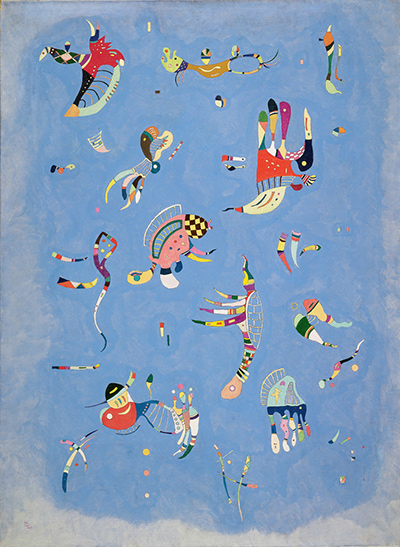Sky Blue from the mind of Wassily Kandinsky is an oil painting created in Paris towards the end of Kandinsky’s career in 1940 during his Great Synthesis period.
To call Sky Blue abstract, while factually accurate does not do justice to the level of abstraction in this painting. The figures in the painting are vibrant, bright and painted with detail, however while they seem familiar they are absurd and ridiculous.
Sky Blue essentially is a blue background with figures in the foreground. The figures in the foreground appear to be low level animals such as invertebrates, however the animals are incomplete and not real.
The background of Sky Blue is blue, softened at times which suggests cloud and thus the sky. In the ‘sky’ are several figures that are seemingly random, but also suggest deliberate placing.
The figures in Sky Blue are bright, colorful and the level of detail is truly remarkable. Traditionally these figures would have been considered the focal feature of this painting, however it could and has been argued that the true focal feature of this painting is the background itself. The blue background is unlike other abstracts or other genres.
Traditionally the background would have softer tones as to that of the foreground to focus the viewer’s attention onto the main attraction of the picture. In Sky Blue, however the tone and strength of color of the background is greater to or at least equal to the strength and color of the figures in the foreground. The question is why did Kandinsky do this and what did he hope to achieve?
The answer to what Kandinsky was attempting to create in Sky Blue was to affect the viewer on an emotional and psychological level. This is like other artists in the abstract expressionism movement who manipulated color, movement, symbolism and lines to affect the feeling and psyche of the viewer. Kandinsky suggested in his writing of abstract art that when art is most expressive, it is less coherent and when the “what?” is asked of a painting, then answering or questioning the “what” further is what feeds the spirit.
The figures in Sky Blue (Bleu de Ciel) do not appear to be anything real, they do not represent anything for certain, however due to the background appearing to be the sky our mind tells us that these figures are in the sky and that these figures are somehow animals in the air. Our minds need to be able to rationalize external stimuli to make sense of the world and through his incoherent imaginary, Kandinsky had achieved this psychological effect.
Sky Blue is not an angry painting, it does not come across as aggressive in its form unlike similar paintings from the time including that from Kandinsky. Sky Blue instead offers the viewer an opportunity to dream through its use of imaginary to allow the viewer to transcend in to a dream-like state. Such paintings allow the viewer to forget about their struggles and instead to dream that it is themselves further through the calming blue sky.
Sky Blue is not as eye-catching as some of Kandinsky’s other creations such as” Several circles”, however it has a timeless quality to it, it is capable of being looked at every day and still feeling as being relevant. Whereas other times, it will fade into the background, waiting for its chance to entice a viewer to create an emotional experience. Sky Blue greatest strength is that even though it does seek excessive attention as it is a private painting happy to be ignored it instead draws the viewer through use of color. Sky Blue springs to life with its use of vibrant colors and shapes drawing the viewer further and further.




